
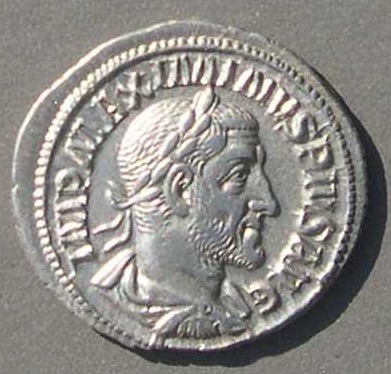

Coins of Maximinus Thrax, Roman emperor 235-238 A.D. (19 March 235 - 24 June 238)
What's new? 2025, Nov. 2: Images linked to larger images--just click on them.
2023, June 7: A very large provincial coin from Tarsos (a second, different, type)
2022, April 17: Large provincial coin from Tarsos.
2021, June 10: Maximus denarius, PRINC IVVENTVTIS
His portraits on silver coins:
 |
 |
 |
| "Early" | "Big chin" | "Late" |
The denarii of Maximinus Thrax (Thrax = "The Thracian") are among the best-produced silver coins of the entire Roman empire. There are three distinct portrait styles. The earliest is simply a modified portrait of the previous emperor, Severus Alexander. Maximinus was unexpectedly elevated to the throne while on the Rhine and, apparently, at first his actual appearance was not known at the mint in Rome.
Maximinus was a literal giant, said to have been the tallest and strongest man in the empire. His biography is fascinating, but this page only discusses the changes in his coin portraits over time. For a biography on the web, see here (Ancient History Encyclopedia) or here (The Online Encyclopedia of the Roman Emperors) or, of course, his Wikipedia entry.
Early Style:
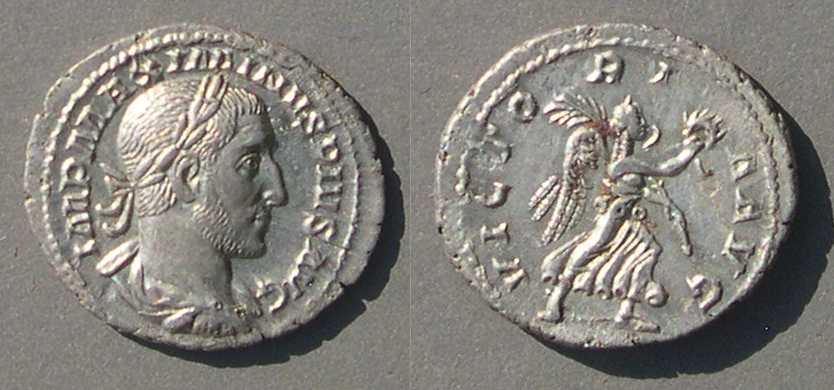
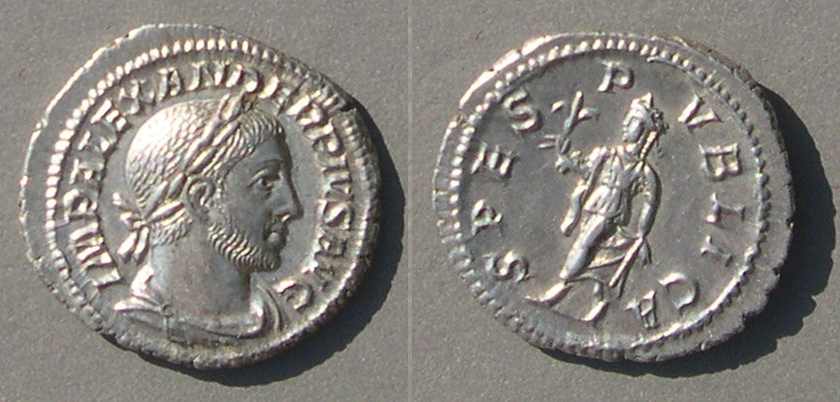
Left: Maximinus I / VICTORIA AVG
Right: Severus Alexander / SPES PVBLICA
The legends, IMP <name> PIVS AVG, are the same except for the name, the hair is cut similarly, and the chin and beard are very similar. The nose is different, with the nose of Maximinus larger and humped and the nose of Alexander straight. The curvature at the top of the nose of Maximinus disappears in the second style and returns as a larger curve in the third.
(The first coin of Maximinus at the top left is 20-18 mm, BMC 25. Sear 8317v, with early style as opposed to the big chin illustrated in Sear. The corresponding SPES PVBLICA coin of Severus Alexander on the right is 20 mm, BMC 898, Sear 7927, struck 232.)
Severus Alexander was only 26 years old when he died and the early portrait reflects the youth of Alexander, not the age of Maximinus who was at least 56 at his accession.
The second portrait style is called "heavy chin" by James Casey and I call it "big chin." The first-issue VICTORIA AVG type (above left) above continues with the big-chin style:
Big Chin:
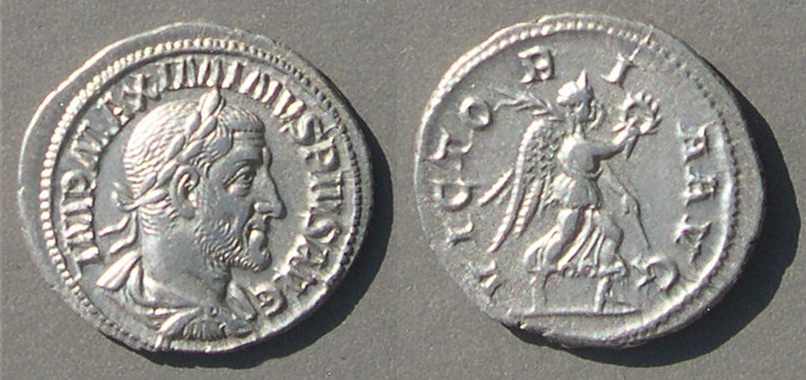 VICTORIA AVG
VICTORIA AVG
Struck May 235 - 236 [Casey]
BMC 105
Sear 8317 (the photo has this big chin, not the early style of the above coin).
20-19 mm. 2.92 grams.
This reverse also exists with the early style portrait [BMC 25, above]
and the late style [BMC 181] which is not illustrated on this web page.
Late Style:
 PM TRP III COS PP (TRP III = year 3)
PM TRP III COS PP (TRP III = year 3)
Struck 237
with the obverse legend omitting "IMP" and adding "GERM" for his German victories:
MAXIMINVS PIVS AVG GERM
BMC 161
Sear 8311
21-19 mm. 3.92 grams.
TRP III is scarce, with only 11 examples among 1855 denarii of Maximinus in hoards listed in BMC, page 88.
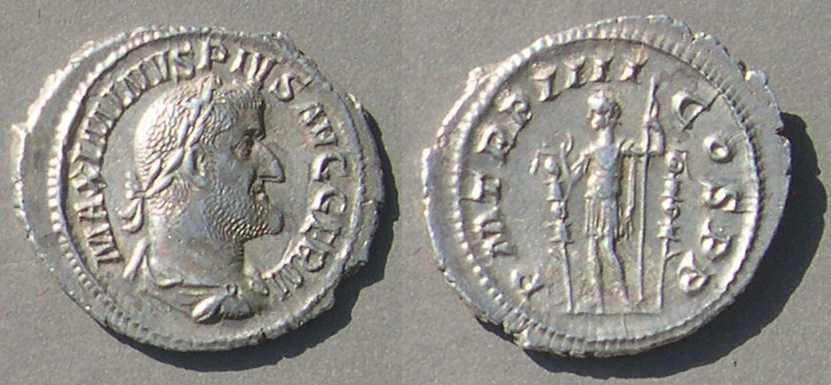 PM TRP IIII COS PP (year 4)
PM TRP IIII COS PP (year 4)Dating
All three portrait styles are illustrated above. Their dating and the associated reverse types are discussed next.
Year 1 began with the early style and continued the same types with the big chin style. This reverse type of a standing soldier holding two standards occurs dated to each of his four years.
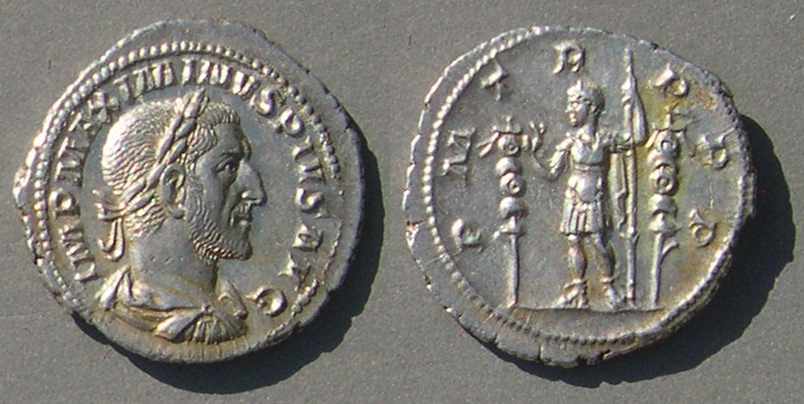
Early style.
PM TRP PP (TRP without a numeral = year 1)
Struck Spring 235 [Casey]
BMC 9
Sear 8311 (his photo has this early portrait)
20-19 mm. 3.58 grams.
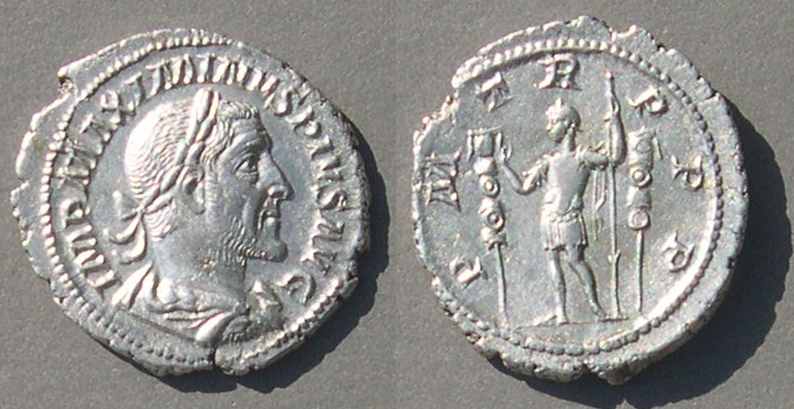 Big chin portrait.
Big chin portrait.
The big chin style continues in year 2:
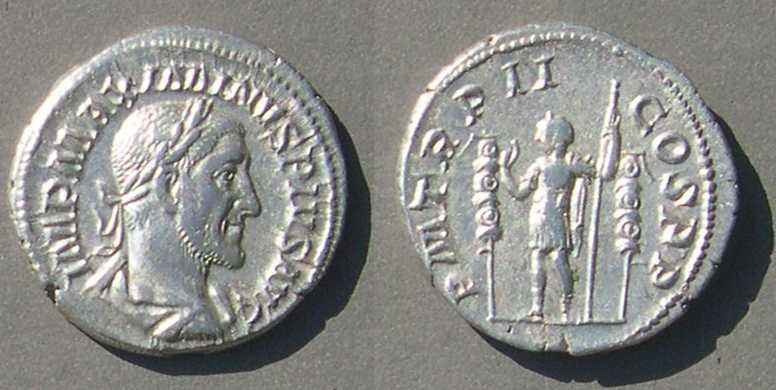 PM TRP II COS PP (year 2)
PM TRP II COS PP (year 2)
Struck 236
BMC 78
Sear 8312 (no photo)
18 mm. 3.19 grams.
[For years 3 and 4 with this reverse design, see above]
[For dating the transition to the later legend and late style portrait, see below.]

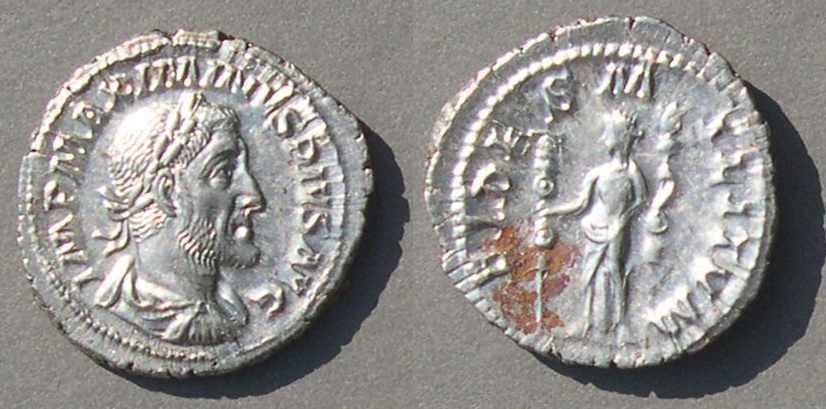 FIDES MILITVM
FIDES MILITVM SALVS AVGVSTI
SALVS AVGVSTI
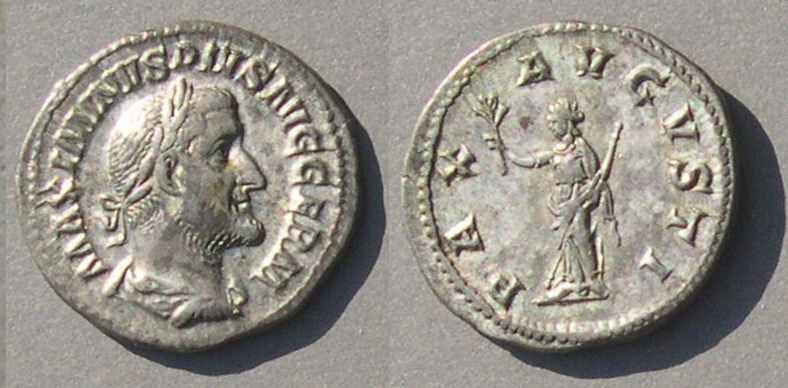 Big chin--but with some features of the late portrait.
Big chin--but with some features of the late portrait.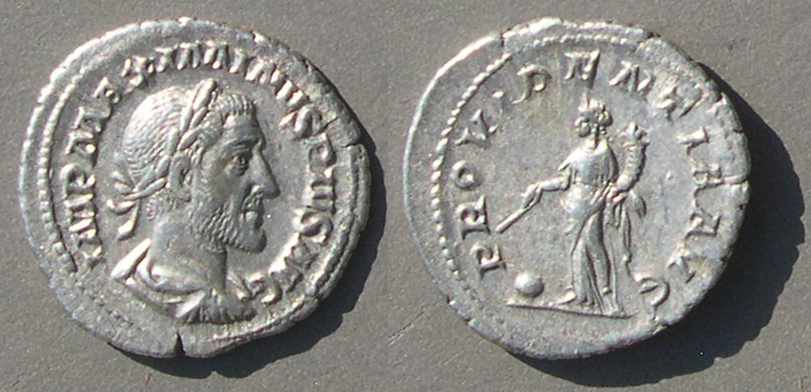 Big chin portriat.
Big chin portriat.
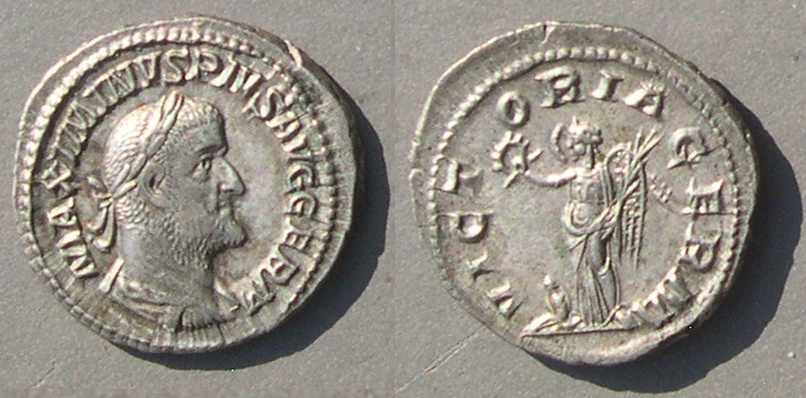
Special Issues
There are three rare types issued in a "special" issue or "consulship" issue of 236 or, perhaps more likely, of mid 235 as soon as possible after his accession.
Early style.
VOTIS / DECENNA /LIBVS
BMC 17
BMC, page 90, comments that this reverse type is found with both the early and big chin portraits.
Sear 8319, not illustrated there.
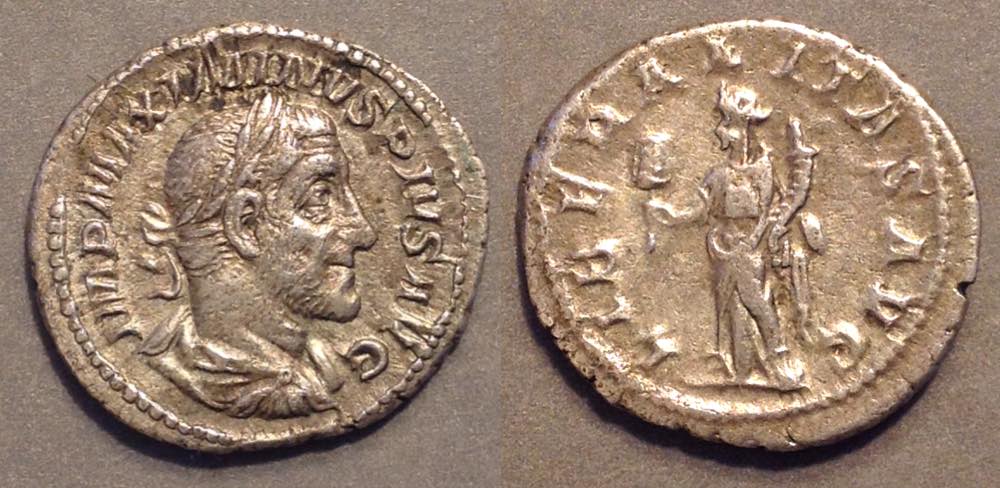
Big chin.
LIBERALITAS AVG
BMC 45
Sear 8309, not illustrated there.
20-19 mm. 3.50 grams.
LIBERALITAS AVG clearly refers to the accession donative, which would have been issued as soon as possible. It seems unlikely that it would have been delayed for nine months until the assumption of the consulship in January 236 as suggested by BMC. The early style portraits on some of these coins and big chin style on others, when attributed to that occasion, forced previous scholars to defer the begining of the big chin style to early 236, but Casey convincingly argues for a lesser duration of this early style, which allows the big chin to begin much earlier -- he thinks May 235, which seems likely.
The other special issue silver type is INDVLGENTIA AVG (Sear 8308, not illustrated) which is illustrated in BMC as 31* (big chin), but the piece is not in the BM (which is why the number is starred. It is in Paris collection).
Note for collectors: Most reverse types of Maximinus are common and frequently offered. Even the historical VICTORIA GERM reverse is common and does not demand a premium. The TPR III and especially the TRP IIII pieces are scarce and distinctly less frequently offered than TRP and TRP II, but there are few specialists to drive their prices up. Expect to pay about the same for those scarce types. The VOTIS special-issue type is rare, obviously special, in high demand, and consequently expensive. The LIBERALITAS AVG type is rare, but not in high demand. Sear gives it only a small premium. The INDVLGENTIA AVG is very rare and Sear gives it triple the value of a regular type, but that low multiple reflects the lack of demand for reverse rarities in his coins.
His Relatives
Maximinus issued rare coins for his son, Maximus, as Caesar and his late wife, Paulina.

Maximus
19 mm. 3.39 grams.
IVL VERVS MAXIMVS CAES
PIETAS AVG
BMC 203
Sear 8404
The date when Maximus became Caesar is unknown, but might be when Maximinus became Augustus. This piece has the obverse legend from the first issue. The legends C IVL VERVS MAXIMVS CAES and MAXIMVS CAES GERM are later.
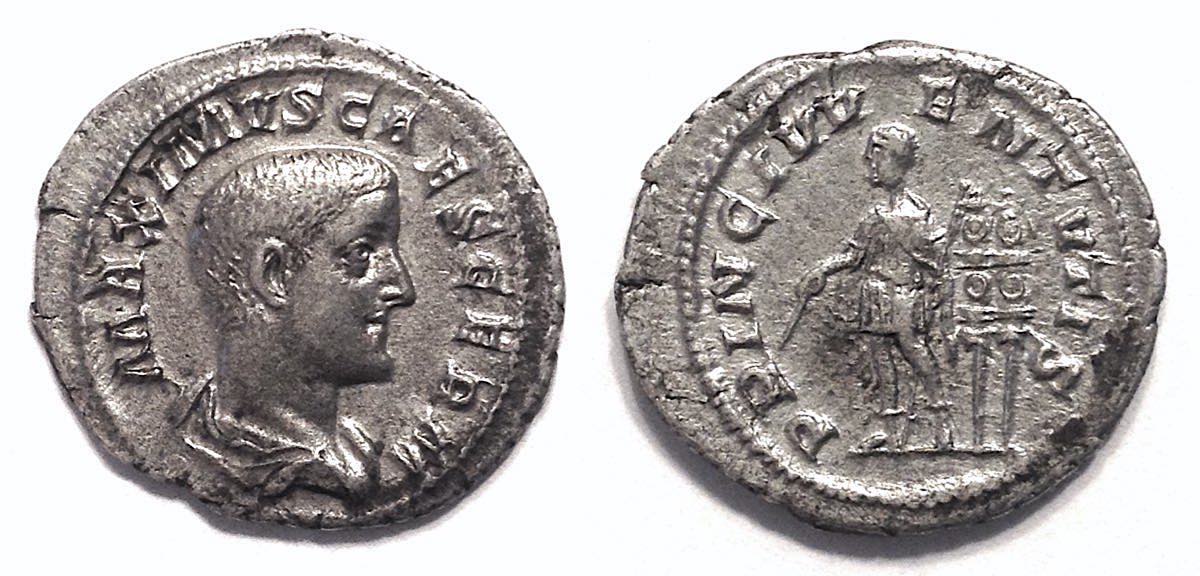
All the coins of Paulina have the obverse legend DIVA PAVLINA. They were all issued posthumously.

Paulina
DIVA PAVLINA
CONSECRATIO
BMC 127
Sear 8400
20 mm. 2.77 grams.
The author of BMC was unaware of any ancient written records that connected Paulina to Maximinus, but the coins clearly did. That she was the wife of Maximinus had been inferred from the the facts that her coins often have his nose and chin line and the coin quality is much like that of Maximimus's coins. That is, the engravers merely put a female spin on his portrait. However, there is a stone inscription from Paestum that mentions them together. Another stone inscription gives the title Augusta to Paulina (suggesting she was alive at the time) but her coins are all posthumous, which may explain why her portraits are not more individual; she was not around to serve as a model for the image.
Note for collectors: Coins of Maximus and Paulina are much rarer than coins of Maximinus. Among hoards published before 1962 (the date of BMC VI) that cover this period, BMC notes 1855 coins of the family, of which only 19 are of Maximus and 1 of Paulina. It is possible that some of the rare Paulina and Maximus coins were found in those hoards, but removed before they were recorded. They don't really seem, on the market, that extremely rare. In any case, prices are not as high as their rarity might suggest because they were not emperors and far more collectors want portraits of emperors than of Caesars and wives.
Conclusion:
The silver denarii of Maximinus are among the best-produced denarii of the entire Roman empire. They come with two obverse legends and three styles--early, big chin, and late. Although the early and big chin styles are beautifully executed, only the late style is likely to be a realisitic portrait.
For further and more-detailed information about the types, see BMC VI.
Of course, the portrait styles appear on other denominations too. What follows is a small sample.
Maximinus I, sestertius, 30-28 mm. 18.44 grams. 12:00.
IMP MAXIMINVS PIVS AVG. "Big chin" style.
SALVS AVGVSTI
Sear 8338 variety (Sear's photo has the final portrait), RIC 85, BMC 101
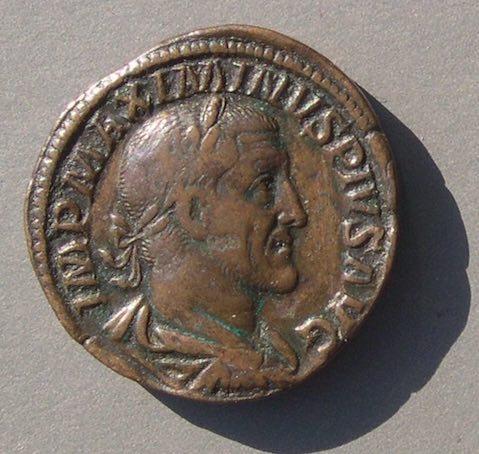
 Maximinus, sestertius, 30 mm, 23.33 grams, 12:00.
Maximinus, sestertius, 30 mm, 23.33 grams, 12:00.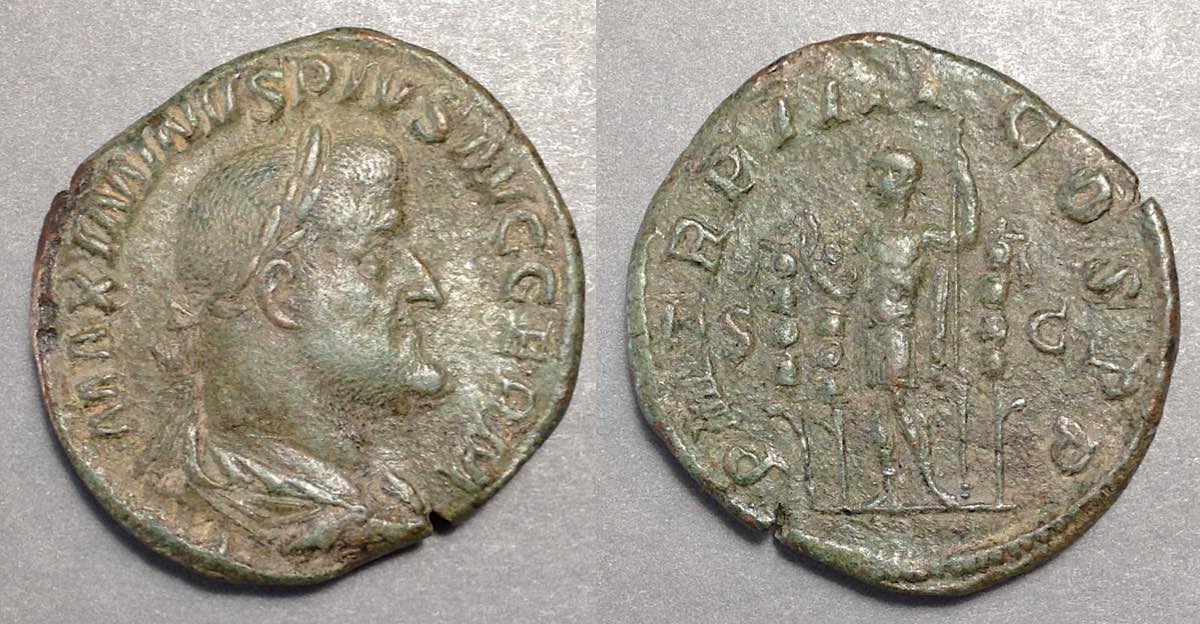
Maximinus, sestertius. 28-26 mm. 14.92 grams. 12:00.
IMP MAXIMINVS PIVS AVG
VOTIS/DECENNA/LIBVS/SC in wreath
Sear 8343. RIC 75. BMC 40.
The VOTIS types (denarius above, dupondius next) are early and usually have the early portrait style. This one, however, is much like the "big chin" style except the chin is not quite so big. Perhaps this die was engraved right at the time of style transition.
Maximinus, dupondius, 26 mm. 10.645 grams. 6:00.
IMP MAXIMINVS PIVS AVG
VOTIS/DECENNA/LIBVS/SC in wreath
Sear 8354. RIC 76. BMC 42.
Early portrait style.
An as:
Maximinus, as, 26-25 mm, 11.47 grams, 12:30.
MAXIMINVS PIVS AVG GERM
SALVS AVGVSTI
Final portrait style.
Sear 8363 variety (8363 is illustrated with the early portrait and without "GERM" in the obverse legend),
RIC 87, BMC 180
Here are sestertii of Maximus:
Maximus, sestertius
30-29 mm. 18.91 grams. 12:00
MAXIMVS CAES GERM
PIETAS AVG
Priestly implements, jug, with lituus, knife and patera to left
simpulum and sprinkler to right.
S C in exergue.
Sear 8409. BMC 204 "late 236-238"
Unlike the weak chin so many children have in real life before their jaws grow, he has a strong chin. Perhaps this is because his chin really did look like his father's, and perhaps the engravers choose to copy his father's features.
 Maximus. Sestertius. 30 mm.
Maximus. Sestertius. 30 mm.
Roman Provincial coins:
There are very many Roman provincial coins of Maximinus and of Maximus. Here is a two-headed type showing both father and son:
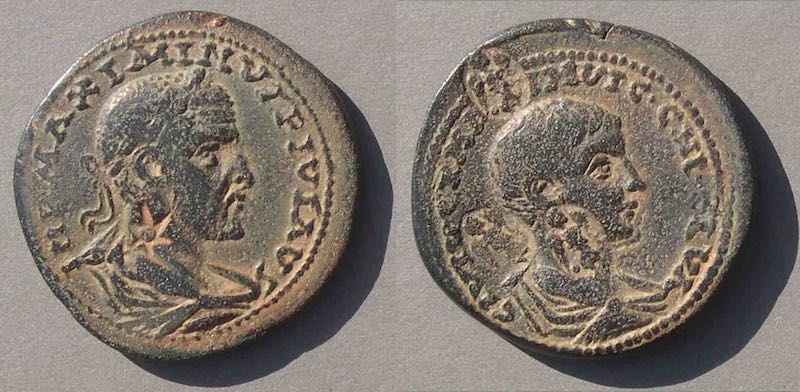 A large 34 mm "sestertius" struck at Ninica-Claudiopolis in Cilicia.
A large 34 mm "sestertius" struck at Ninica-Claudiopolis in Cilicia.
Maximinus / Maximus
IMP MAXIMINVS PIVS AVG / C IVL MAX MAXIMVS C C NI CLVA
The obverse has a star countermark on the neck and the reverse has a Victory countermark struck three times.
L&K 1561 and A1561A. SNG Levante 620 variety. Howgego countermarks 451/262.
Sear GI --, Lindgren III --, Weber --, SNG Copenhagen --, von Aulock --.
 Maximinus
Maximinus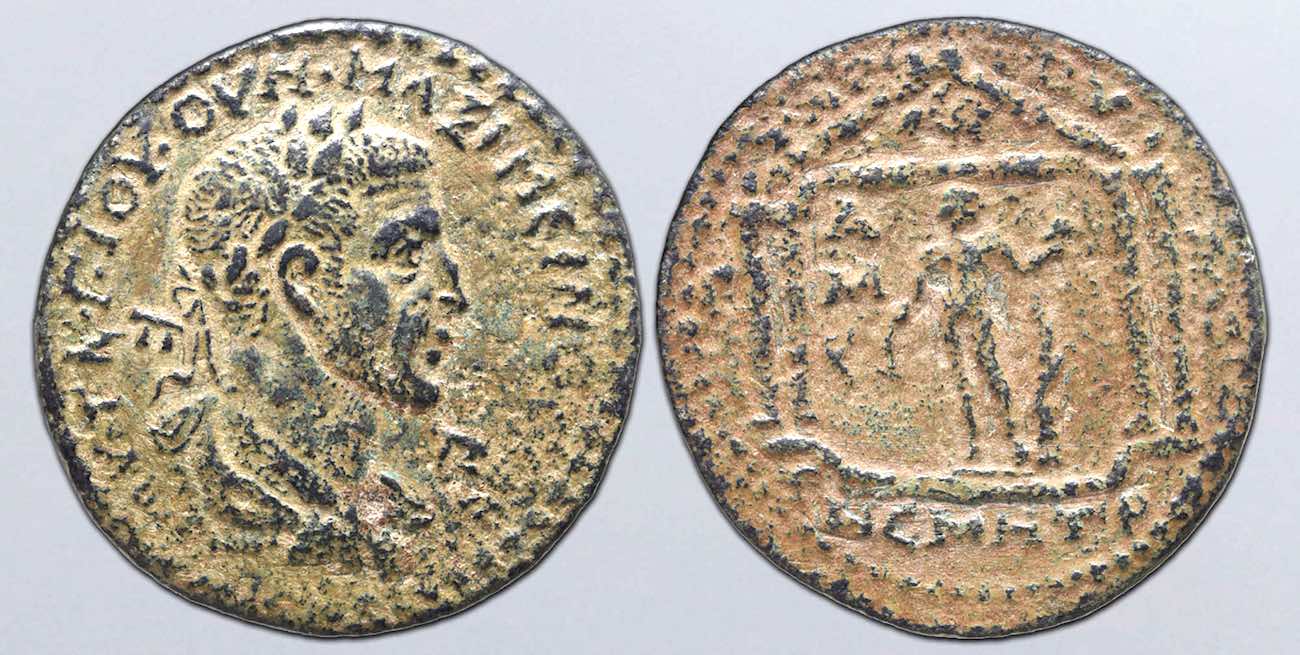 Maximinus
MaximinusRoman Alexandria issued coins of Maximinus in years 1 through 4.
Maximinus, Alexandria mint year 1
Early portrait with no sign of a prominent chin.
AVTO MAΞIMINO CEVE CEB
LA = year 1
Jupiter (Zeus) seated left on throne, holding out patera in right and holing long vertcal scepter in left, eagle at feet
Emmett 3306, Sear --, cf. 8369
Maximinus, Alexandria mint year 4
23 mm. 13.56 grams
AVTO MAΞIMINO CEV CEB
Athena seated left holding Victory in right and long scepter in left, shield at the seat
LΔ = year 4
Emmett 3275Δ, Sear 8381v (His is year 3)
In spite of it being his last year, the chin is not prominent like it is on imperial coins.
For references, see the page of references.
Return to the table of contents of this site.